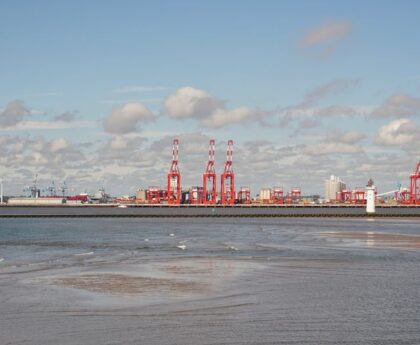Tragedy Strikes as Submarine Goes Missing on Titanic Expedition
A submarine participating in a tourism expedition to explore the wreckage of the Titanic has gone missing off the coast of southeastern Canada. The submarine, named Titan, was carrying a group of wealthy adventurers who had paid a hefty price for the opportunity to see the infamous shipwreck up close. The incident has sent shockwaves through the tourism and exploration communities, raising questions about the safety and ethics of such expeditions.
The Allure of the Titanic and Adventure
The Titanic has long captivated the imaginations of explorers and history enthusiasts alike. The supposedly “unsinkable ship” met a tragic fate on its maiden voyage in 1912, claiming the lives of 1,500 individuals. In recent years, the opportunity to witness the Titanic‘s wreckage through submarine tours has become available for those willing to pay exorbitant ticket prices.
OceanGate Expeditions, the company behind these tours, attracts a unique breed of travelers known as “citizen explorers.” These individuals not only seek adventure but also actively participate in the research mission to the maritime heritage site. This hands-on approach sets the Titanic tours apart from traditional tourism ventures, appealing to those who crave a deeper connection with history and a sense of exploration.
The Titan Submarine: The Vessel of Discovery
The Titan submarine, a carbon-fiber submersible, is the centerpiece of the OceanGate Expeditions’ Titanic tours. Capable of carrying five people — one pilot and up to four paying guests — the Titan offers a once-in-a-lifetime opportunity to explore the depths of the Atlantic Ocean and witness the remnants of the ill-fated luxury liner. With a dome window at the front, passengers can marvel at the otherworldly views, while the pilot operates the controls from behind.
Despite the cramped quarters and the necessity to limit one’s diet before the journey, the allure of exploring the Titanic site has drawn in past adventurers, including renowned filmmaker James Cameron. OceanGate Expeditions emphasizes that this experience is only for those with deep pockets and a willingness to embrace the close confines of the submarine.
Into the Depths: The Ill-Fated Expedition
On June 16, a group of approximately twelve paying explorers set off from St John’s Harbour, Newfoundland, Canada, aboard the Polar Prince, the ship chartered to launch the submarine. With stormy seas and reports of the worst winter in forty years, the expedition was not without its challenges from the start.
After sailing 350 miles to the coordinates of the Titanic wreckage, the explorers were scheduled to spend eight days on board the Polar Prince, taking turns completing the eight-hour submarine missions. Photos posted online showcased the foreboding gray seas that surrounded them, highlighting the immense risk these adventurers willingly undertook in pursuit of their Titanic experience.
Loss of Contact and Concerns for Safety
Moments of enthusiasm and anticipation turned to worry and sorrow when an hour and 45 minutes into the mission, contact with the Titan submarine was lost. The Polar Prince’s crew, ocean exploration experts, and executives from OceanGate Expeditions have launched an extensive search and rescue operation to locate the missing submarine and its occupants.
The submarine, equipped with a 96-hour air supply, is designed to automatically resurface in the event of an emergency. Additionally, it maintains contact with the surface vessel through Elon Musk’s Starlink internet connection. Despite these safety measures, the sudden loss of contact heightens concerns about the inherent risks associated with deep-sea exploration.
Evaluating the Ethics and Safety of Titanic Expeditions
The disappearance of the Titan submarine prompts an examination of the ethical and safety considerations surrounding Titanic tours and deep-sea exploration as a whole. Critics argue that these expeditions exploit tragedy for profit, commodifying a historic disaster and the loss of so many lives. They question the appropriateness of turning a site of mourning into a tourist attraction, even with the inclusion of research objectives.
Moreover, critics raise concerns about the safety protocols and potential risks associated with such deep-sea journeys. While the technology and precautions taken by companies like OceanGate Expeditions are significant, the inherent dangers of exploring the depths of the ocean cannot be entirely eliminated.
Editorial: Balancing Adventure and Responsibility
The disappearance of the Titan submarine serves as a somber reminder of the risks inherent in pushing the boundaries of exploration. As humans, we have an innate desire to discover, to challenge ourselves, and to connect with history. However, we must strike a delicate balance between satisfying these desires and ensuring the safety and preservation of our planet’s natural wonders.
At a time when our oceans face unprecedented threats from climate change and human activity, it is crucial that we approach deep-sea exploration with caution and respect. The allure of adventure should not overshadow our responsibility to protect and preserve these fragile ecosystems and historic sites.
Advice: Responsible Exploration and the Role of Regulation
For future generations of explorers and adventure-seekers, it is imperative that we establish clear guidelines and regulations to govern deep-sea expeditions. By setting standards for safety, environmental impact mitigation, and ethical practices, we can strive to strike a balance between adventure and responsibility.
Additionally, companies involved in deep-sea exploration must prioritize transparency, ensuring that potential risks and challenges are openly communicated to prospective participants. This transparency will allow individuals to make informed decisions about their involvement and acknowledge the potential hazards they may encounter.
Lastly, we must embrace a philosophy of responsible exploration, one that acknowledges the wonders of our planet while respecting the delicate balance of nature. As we continue to delve into the depths of our oceans, let us do so with mindful intentions and a commitment to preserving the beauty and history that lies beneath.
Conclusion: A Tragic Reminder of the Perils of Pursuit
The disappearance of the Titan submarine is a tragic event that shines a spotlight on the risks inherent in deep-sea exploration. While the allure of experiencing historic sites such as the Titanic may be tempting, we must not forget the potential dangers that accompany such ventures. It is essential that we approach exploration with a balanced perspective, appreciating the thrill of discovery while also prioritizing safety, ethics, and environmental stewardship. Only then can we truly honor the legacies of those who have come before us and ensure a sustainable future for generations to come.

<< photo by Oziel Gómez >>
The image is for illustrative purposes only and does not depict the actual situation.




